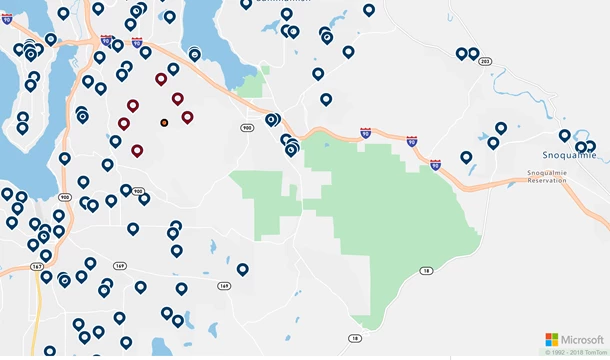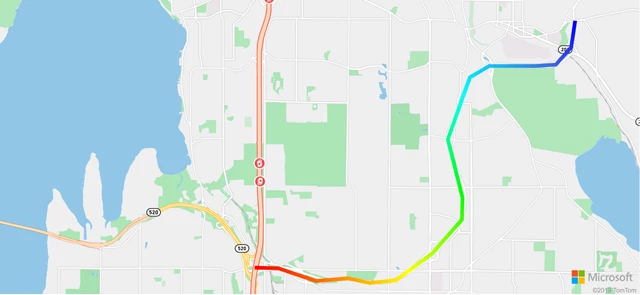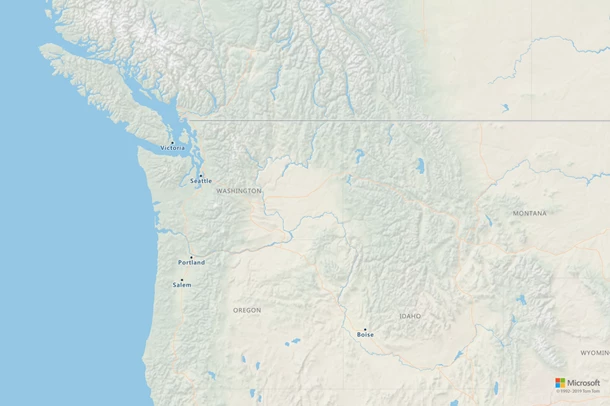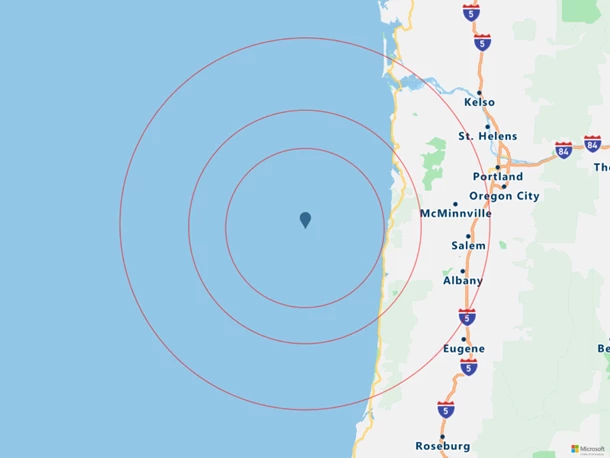Announcements, Azure Maps, Internet of Things, Web
Actuating mobility in the enterprise with new Azure Maps services and SDKs
Posted on
7 min read
The mobility space is at the forefront of the most complex challenges faced by cities and urban areas today. The movement of people and things is as much a driver of opportunity as it is an agent of chaos, aggravating existing challenges of traffic, pollution, and unbalanced livelihoods. Today, Azure Maps is continuing to expand the offerings of our platform, introducing a new set of capabilities in the form of SDKs and cloud-based services, to enable enterprises, partners, and cities to build the solutions that will help visualize, analyze, and optimize these mobility challenges.
The services we’re introducing are designed exclusively for the needs of the modern enterprise customer – powerful, real-time analytics and seamless cross-screen experiences, fortified by robust security services.
First, we’re officially moving the following services from public preview to general availability: Route Range {Isochrones}, Get Search Polygon, and Satellite and Hybrid Imagery. Furthermore, we’re introducing multiple new services. We’re enhancing our map canvas by introducing a stunning set of shaded relief map tiles and an image compositor to make interaction with our maps more aesthetic, useful, and powerful. We’re also introducing Spatial Operations services that offer powerful analytics used by mobility applications and other industries today, as well as a new Android SDK and a Web SDK that equip Azure customers with the tools necessary to make smarter, faster, more informed decisions. And because privacy and security are top of mind, Azure Maps is now natively integrated with Azure Active Directory, making access to our services more secure while enabling roles and restrictions to our customers.
These services will provide Azure customers with the ability to offload map data processing and hosting costs all while getting the benefits of a rich set of maps and mapping services, securely with the fastest map data refresh rate available today. This refresh rate of data and services is bolstered by the recently announced partnership with TomTom who has committed to moving their map-making workloads to the Azure cloud significantly shortening the time from impetus to end user.
Android SDK (Preview)
While the Azure Maps Web SDK can work within a web control on mobile platforms, many developers prefer native support to interoperate with other native components and have these capabilities in native code… Java != JavaScript. In support of our customers who rely on applications running on Android, Azure Maps is distributing an Android SDK, complete with rendering maps and traffic, drawing, event handling, and using the variety of our map canvases. You can also connect to other Azure Maps services such as Search and Routing though the Azure Maps services APIs.

Spatial Operations (Preview)
Data analysis is central to the Internet of Things (IoT). Azure Maps Spatial Operations will take location information and analyze it on the fly to help inform our customers of ongoing events happening in time and space, enabling near real-time analysis and predictive modeling of events. Today Spatial Operations includes the following services:
Geofencing. A geofence is an “invisible fence” around a particular area. These “fences” exist in coordinates in the shape of customizable polygons and can be associated with temporal constraints so that fences are evaluated only when relevant. Furthermore, you can store a geofence Azure Maps Data Service (more on that below). With Azure Event Grid integration, you can create notifications whenever the position of an object changes with respect to a geofence – including entry, exit, or changing proximity to a geofence.
This has multiple applications. In transportation and logistics, it can be used to create alerts when cargo ships have arrived at waypoints along routes – critical for creating delivery alerts as well as for anticipating incidents of piracy. For drones, a geofence could enforce the limitation of where a drone is permitted to fly.

However, geofencing isn’t limited to transportation. In agriculture, it can enable real-time notifications when a herd has left a field. In construction, you can receive a notification when expensive equipment leaves a construction site that it shouldn’t be leaving or when it is parked in an area that may cause damage to equipment. It can also be used to warn site visitors when entering hazardous zones on sites, as implemented by Scottish IoT technology firm, Tagdat. In services, vending machines in college dorms often disappear. The servicing company can be notified if the machine leaves the premises. Geofencing is an amazingly powerful service to provide notifications and analytics when objects are moving. And, even when objects aren’t moving and should be!
Another example of a customer that is using this service is GovQA who state, “We use geofencing to identify when a requester is trying to submit a request which is outside the customer’s pre-defined limits. The limits are defined by the city or county during the set up of the system. This allows the city to correctly handle the request and communicate with the requester appropriately using rules and configurations within GovQA.”
Buffer. Build an area around points, lines, and polygons based on a given distance. Define the area in proximity of powerlines that should be kept clear from vegetation or create route buffers in fleet management for managing route deviations.
Closest Point. Returns the closest points between a base point and a given collection of points. It can be used to quickly identify the closest stores, charging stations, or in mobility scenarios, it could be used to identify the closest devices.

Great-circle distance. Returns the great-circle or shortest distance between two points on the surface of a sphere. In the context of drone delivery services, this API can be used to calculate the distance between an origin and destination as the crow flies taking into account the curvature of the earth so that a accurate time estimate for the delivery can be taken into account to optimize operations.
Point in Polygon. Returns a Boolean indicating whether the location is inside a given set of Polygon and MultiPolygon geometries. For example, the point in polygon API can be used to determine whether a home for sale is in the preferred area of customers.
Data Service (Preview)
Data is an imperative for maps, and bringing customer data closer to the Azure Maps service will reduce latency, increase productivity, and create powerful, new scenarios to light up in your applications. As such, Azure Maps will now have the ability for customers to upload and store up to 50MB of geospatial data for use with other Azure Maps services, such as geofencing or image composition.
Azure Active Directory Integration (Preview)
Security and role-based access control have been of paramount concern for the modern enterprise. As such, we’re proud to announce that Azure Active Directory (AD) is now a core capability of Azure Maps. Use Azure AD to protect your customers’ information and implement secure access by providing role-based access control (RBAC). Whether you have public applications or applications requiring a login, Azure AD and Azure Maps will support your security needs by authenticating your applications and Azure AD user(s). Additionally, this Azure AD implementation supports managed identities for Azure resources which provide Azure services (Azure App service, Azure Functions, Virtual Machines, etc.) with an automatically managed identity that can be authorized for access to Azure Maps services.
Azure Maps Web SDK 2.0
Today we’re announcing a new module for accessing Azure Maps services to use in conjunction with the Azure Map Control. The new Service Module allows you to natively work directly with the Azure Maps services. This new module, plus the aforementioned adoption of Azure Active Directory, warranted the need for creating a new version and encapsulating them into a single Web SDK. Henceforth, we’ll containerize our services for web developers into the Azure Maps Web SDK 2.0. Note that the Azure Map Control 1.x will continue to be operational. However, we will innovate on 2.0 moving forward. The upgrade path for 1.x to 2.0 is quite simple by changing the version number! As a part of the new Azure Maps Web SDK 2.0 we’re also including some new client features:
Azure Active Directory (AAD). Azure Maps now natively supports Azure Active Directory to keep your access to Azure Maps secure. With native AAD integration, ensure your access is protected when your applications call Azure Maps.
Services Module. The new Services Module adds support for AAD and a much cleaner API interface for accessing Azure Maps services. It works with both the Web SDK and also in NodeJS. Being part of the Azure family of products, the Azure Maps Services Module was designed to align with an initiative to unify Azure SDKs and was required in order to add support for AAD.
Stroke gradients. There are times in location services development when you’d want to have gradient colors throughout the stroke of a line. Azure Maps Web SDK 2.0 now natively supports the ability to fill a line with a gradient of colors to show transition from one segment of a line to the next. As an example, these gradient lines can represent changes over time and distance, or different temperatures across a connected line of objects.

Shaded Relief map style. Below you’ll read about the new Shaded Relief Map Style. This beautiful, new map style is available immediately in the Azure Maps Web SDK 2.0.
Polygon Fill Patterns. Representations of polygons on a map can be done in a plethora of ways. In many scenarios, there will be a need to create polygons on the map. With the Azure Maps Web SDK 2.0 there is native control for shapes, borders, and fills. Now, we natively support patterns as a fill in addition to a single color fill. Patterns provide a unique way to highlight a specific area to really make it standout, especially if that area is surrounded by other color-shaded polygons. As an example, patterns can be used to show an area in transition, an area significantly different from other areas (such as financially, population, or land use), or areas highlighting facets of mobility such as no-fly zones or areas where permits are required.

Shaded Relief map style
Azure Maps comes complete with a few map styles including the road, dark gray, night, and satellite/hybrid. We’re adding a new map style – Shaded Relief – to complement the existing map styles. Shaded Relief is just that – an elegantly designed map canvas complete with the contours of the Earth. The Azure Maps Web SDK comes complete with the Shaded Relief canvas and all functions work seamlessly atop of it.

Image composition
Azure Maps is introducing a new image compositor that allows customers to render raster map images annotated with points, lines, and polygons. In many circumstances you can submit your request along with your respective point data to render a map image. For more complex implementations, you’ll want to use the map image compositor in conjunction with data stored in the aforementioned Azure Maps Data Service.

We always appreciate feedback from our customers. Feel free to comment below or post questions to Stack Overflow or our Azure Maps Feedback Forums.